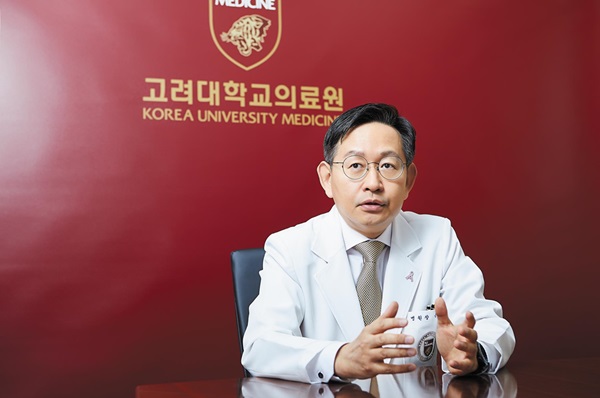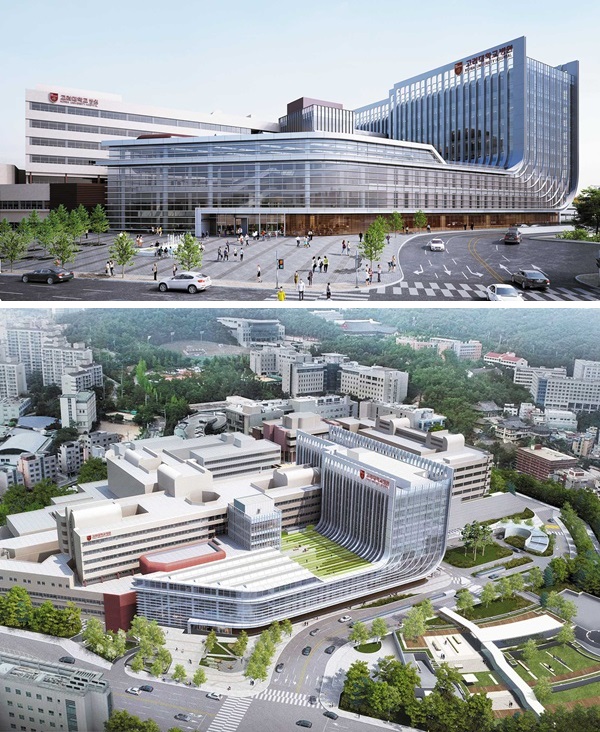RELATED Live
Dr. Yoon Eul-sik declares “a giant leap” in inaugural speech
New building dubbed “smart hospital” set to be completed early next year
Patient-centered care with smart information system
Increased work efficiency through digital healthcare

(Photograph) President Yoon Eul-sik of Korea University Anam Hospital explains the hospital’s vision.
Korea University Anam Hospital (KUAH) is poised to make giant strides. The new building, incorporating an unprecedented smart hospital system, will be completed early next year. Along with this, Dr. Yoon Eul-sik, who declared the plans to turn KUAH into a first-class hospital, recently took office as President. President Yoon said, “A first-class hospital is a place that puts patients at the forefront. I will dedicate my efforts to realization of a super-interdisciplinary healthcare system that takes conventional healthcare to the next level.” I personally visited the KUAH with high expectations for its future.
◇ Set to realize super-interdisciplinary, patient-centered care
The first step towards KUAH’s goal of becoming a first-class hospital is super-interdisciplinary care. “The best care for patients is interdisciplinary care whereby professors from various departments concerned with a given disease meet and make diagnoses together,” said President Yoon Eul-sik, who explained, “Super-interdisciplinary care, applying an interdisciplinary approach from diagnosis to post-treatment follow-up observations, is a new concept of healthcare process that has advanced interdisciplinary care to the next level.” There are few hospitals that actually even apply an interdisciplinary approach, as it is generally difficult for multiple professors to get together at the same place and time. Super-interdisciplinary care, where the approach is applied throughout all processes including diagnosis, treatment, follow-up, and patient management, is obviously much more challenging. However, KUAH is convinced that it will be able to quickly introduce super-in disciplinary care throughout the hospital. “We have already established this system for foreign patients at the International Healthcare Center. We will realize patient-centered care, in the true sense of the term, and it will maximize convenience for patients even in the area of telemedicine,” said President Yoon.
Digital health care and collaboration among medical departments will be key to the super-interdisciplinary care envisioned by KUAH. It plans to reduce unnecessary workloads for its medical staff by utilizing digital healthcare technology such as automated work schedule creation and voice recognition. This is expected to raise work efficiency and create an environment in which medical staff can better focus on their patients. With telemedicine, patients can experience a reduced number of hospital visits and also shorter waiting times for examination and treatment.
“Emptying the bulb of a surgical drain can be explained effectively through telemedicine. This is already applied in the United States. [Telemedicine] will offer great convenience for patients who face difficulty visiting hospitals, such as those living in island areas,” President Yoon explained.
◇ Digital healthcare ward set to open
Another system that KUAH is looking to establish as part of its aim to become a first-class hospital is digital healthcare. KUAH is already using various cutting-edge technologies such as a mobile app, kiosks, and Hi-Pass. The mobile app that was recently launched provides information related to the medical services provided at the hospital, thereby enhancing patient convenience. There are plans in the offing to launch a messenger to further enhance convenience and speed of communication between medical staff and patients. Kiosks have been set up in the hospital to allow patients to pay their medical bills without waiting. New patients can register for a hospital card which can be used to pass through the Hi-Pass system for making automatic payments.

(Photograph) Conceptual drawing of the new KUAH building
Digital technology is also incorporated into the administration system for the sake of efficient patient management. Due to the nature of medical institutions that have to monitor patient health 24 hours a day, creating an accurate work schedule is crucial, and pilot operation of an automated AI work scheduling system has recently begun. Patient safety management will also be strengthened by using infusion management and monitoring systems. There are also plans to introduce a mobile chart with an AI voice recognition and recording feature to reduce the time spent looking at the chart, allowing medical staff to focus more on the actual patients.
These technologies will be applied at the new KUAH building, which has been under construction since 2017. Scheduled for completion early next year, the new building is expected to improve the convenience of patients and visitors significantly with the implementation of systems that apply information and communication technologies such as IoT and various other technologies of the Fourth Industrial Revolution. As such, this is a new type of hospital in which medicine will combine with frontier technology.
President Yoon said, “We are building a state-of-the-art convergence medical center with various large corporations, such as Naver, Kakao, and LG Electronics, with which we have signed business agreements. Once the new building is constructed, the main building will be remodeled and equipped with an AI system to enhance operational efficiency and patient safety.”
◇ Managing massive amounts of data using a system developed in-house
KUAH also has what it takes to implement digital healthcare. It is saving immense data through use of Korea’s first cloud-based precision medicine hospital information system (P-HIS) developed by Korea University Medical Center and which has gained external recognition. P-HIS was ranked third in the world in an evaluation of digitalization of hospital medical systems by the North American Medical Information and Management Systems Society (HIMSS), the world’s largest medical IT society. That evaluation, the results of which are expressed as a digital health indicator (DHI), measures progress toward achievement of a digital medical ecosystem. KUAH became the first medical institution in Korea to receive such a HIMSSDHI evaluation.
President Yoon said, “Using the vast amounts of data accumulated on P-HIS, it will be possible to go beyond treating diseases and even prevent them in advance. We will also conduct active medical research to contribute to bolstering Korea’s competitiveness on the world stage.” P-HIS is expected to play a major role in turning digital healthcare into a reality. With an intensive research system and big data utilization technology, it will be possible to provide optimized treatment for each patient, and precision medicine can be applied not only to cancer treatment but also to other serious conditions such as heart disease, cerebrovascular disease, and rare intractable diseases. It will also be used in research and development (R&D) of new drugs, new medical devices, new surgical methods, and clinical trials to increase disease treatment possibilities. This is also made possible by the current research capacity of KUAH, which has been designated an Excellent Research-Centered Hospital by the state.
Interview with Yoon Eul-sik, President of Korea University Anam Hospital
“As soon as I started thinking from the patients’ perspective, everything was resolved.”
“Thinking from the patients’ perspective resolved everything.”
Throughout the interview, President Yoon of KUAH stressed “patient-centeredness.” “The most important and critical value at a hospital is its patients,” said President Yoon before adding, “Whenever I had to make a decision, it became easier when I thought from the patients’ perspective.” One of the solutions he came up with this approach is the concept of super-interdisciplinary care, whereby professors from all departments necessary for treating a patient’s condition are involved across all the steps from treatment to follow-up management.
President Yoon said, “There are numerous patients who need our help but face limitations because they live far away. We will address these issues by applying cutting-edge technology.”
When asked what the second most important value after patients was, he found the answer in patients. He said, “For patients to be comfortable, the hospital staff must be happy. Due to the nature of hospitals where various professionals work together, an understanding and cooperation among all members of the team are a crucial driving force behind the hospital operation.” In fact, as soon as he took office, he organized the Mutual Respect Task Force and conducted campaigns such as changing the title by which the staff are addressed.
Inquiry